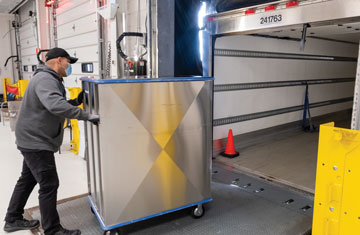The instrument care professionals who run offsite reprocessing centers provide standardized cleaning, sterilization and maintenance/repair services with strict quality control. They pick up soiled instruments, transport them to a large reprocessing
facility, clean and sterilize the tools and return repackaged trays that are ready for use in surgery.
As outpatient ORs become popular destinations for common and complex procedures, health systems and independent ASCs are rethinking the instrument reprocessing model. Does it make sense for an expanding health system with multiple surgery
centers to build a centralized reprocessing facility? Should freestanding ASCs without the resources or room to expand their sterile processing capabilities partner with an offsite reprocessing service? For most health systems and surgery
centers that invest in outsourcing alternatives, the appeal seems to be twofold: creating more space to serve patients while streamlining and standardizing the sterilization process. An ASC that wants to dedicate more square footage to
new ORs in response to increasing case volumes can create more in-house space without needing to physically expand, and gaining more room to treat patients can increase profitability.
It makes good strategic sense to work with a company that’s expert in high-quality, on-time tray deliveries.
— Adam Royer
OrthoIllinois Surgery Center in Rockford, Ill., partnered with an offsite reprocessing service, a move that has increased its surgical capacity and reduced instrument backlogs for total joint replacements. “We had reached capacity in
our sterile processing department (SPD) and needed to get creative if we were going to process instrument trays quickly enough to accommodate more cases,” says Leanne Brennan, the center’s business manager.
The Ohio State University Wexner Medical Center will open a freestanding surgical equipment sterilization facility in Columbus in 2026 with an estimated investment of more than $45 million. The 62,000-square-foot space will serve the health
system’s main medical center and outpatient care centers. The facility will ultimately be able to accommodate the reprocessing of surgical instruments serving upwards of 48,000 patients per year.
When the new facility is completed, OSU will become one of the largest academic health centers to implement this freestanding model. In addition to instrument reprocessing, the facility will repair, refurbish and maintain instrumentation.
OSU’s goal is to build an instrument care workflow that’s consistent throughout the entire health system. “Offsite instrument reprocessing will allow our team to work more efficiently as we elevate the quality of care to
our patients,” says Kim Jones, director of central sterile supply at Wexner Medical Center.
Erlanger Health System in Chattanooga, Tenn., is a multi-hospital system that performs about 35,000 surgeries a year in approximately 60 operating rooms across several campuses. That’s a lot of instruments that need to be reprocessed,
and the number will only increase as case volumes continue to climb. “Investing in a state-of-the-art onsite SPD is difficult to do because the return on investment is tied to surgical volume, not instrumentation,” says Adam
Royer, BSN, RN, senior director of surgical services at Erlanger Health. “The other challenge is finding enough square footage in a landlocked facility to update and expand the department.”
Mr. Royer determined that a complete overhaul and upgrade of his hospital’s SPD wouldn’t be able to support the facility’s case volumes. Erlanger Health’s other hospitals, which continue to perform record numbers of
cases each year, were also nearing instrument reprocessing capacities. He began looking for an offsite location that could support the health system’s current and future instrument reprocessing needs.
Erlanger Health recently inked a long-term partnership with a third-party offsite reprocessing center that will care of the health system’s instruments over the next two decades. Mr. Royer still moved forward with upgrading his hospital’s
SPD in its current footprint to maintain some onsite reprocessing capability, which can keep the hospital running at 60% of its case volume capacity.
.svg?sfvrsn=be606e78_3)

.svg?sfvrsn=56b2f850_5)